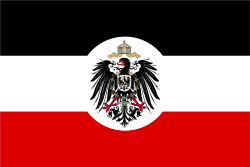Juye Incident

The Juye Incident (Chinese: 曹州教案 or 巨野教案; pinyin: Cáozhōu Jiào'àn or Jùyě Jiào'àn) refers to the killing of two German Catholic missionaries, Richard Henle (b. 21 July 1863 at Stetten near Haigerloch) and Franz-Xavier Nies (b. 11 June 1859 at Rehringhausen, Olpe, Roman Catholic Archdiocese of Paderborn), of the Society of the Divine Word, in Juye County Shandong Province, China on 1 November 1897 (All Saints' Day).[1]
The missionaries were attacked by a band of twenty to thirty armed men who broke into the mission compound in Zhang Jia Village (Chinese: 張家莊; pinyin: Zhāng Jiā Zhuāng, Tshantyachuang),[2] about 10 km northeast of the town of Juye; the likely target of the attack was the priest stationed there, George Maria Stenz (薛田资, 22 November 1869 - 23 April 1928). It is not certain who committed the killings, but it is most commonly assumed that the attack was launched by members of the Big Swords Society[3]
Less than two weeks after the attack, Germany used these murders as a pretext to seize Jiaozhou Bay on Shandong's southern coast; under German threats, the Qing government was also forced to remove many Shandong officials from their post (including governor Li Bingheng) and to build three Catholic churches in the area (in Jining, Caozhou, and Juye) at its own expense.[4] The mission that had been attacked also received 3,000 taels of silver in compensation for stolen or damaged property, and received the right to construct seven fortified residences in the area, also at government expenses.[5] This settlement strengthened missionary work in Shandong province and was part of the events that led to the Boxer Uprising (1899–1900), a movement directed against the Christian and foreign presence in northern China.[6] Imitating Germany, other powers (Russia, Britain, France, and Japan) began "a scramble for concessions" to secure their own sphere of influence in China.[7]
Historian Paul Cohen has called the Juye incident "the opening wedge in a process of greatly intensified imperialist activity in China,"[8] whereas Joseph W. Esherick comments that the Juye killings "set off a chain of events which radically altered the course of Chinese history."[9]
Notes
| Wikimedia Commons has media related to Juye Incident. |
Bibliography
- Clark, Anthony E. (2011), China's Saints: Catholic Martyrdom During the Qing (1644–1911), Lexington Books.
- Cohen, Paul (1997), History in Three Keys: The Boxers as Event, Experience, and Myth, New York: Columbia University Press, ISBN 0-231-10651-3.
- Esherick, Joseph W. (1987), The Origins of the Boxer Uprising, Berkeley and Los Angeles: University of California Press, ISBN 0-520-06459-3.
- Stenz, Georg-Maria (1915), Life of Father Richard Henle, S.V.D. missionary in China : assassinated November 1, 1897, Techny, IL: Mission Press, S.V.D.
- Tiedemann, R. G. (2007a), "The Church Militant: Armed Conflicts between Christians and Boxers in North China", in Robert Bickers and R.G. Tiedemann (eds.), The Boxers, China, and the World, Plymouth: Rowman & Littlefield, pp. 17–41, ISBN 978-0-7425-5395-8.
Further reading
- Catholic Cyclopaedia: Chinese Martyrs
- Tiedemann, R. G. (2007b). "Not Every Martyr is a Saint! The Juye Missionary Case of 1897 Reconsidered." In Noel Golvers and Sara Lievens (eds.), A lifelong dedication to the China mission: essays presented in honor of Father Jeroom Heyndrickx, CICM, on the occasion of his 75th birthday and the 25th anniversary of the F. Verbiest Institute, K.U. Leuven. Leuven Chinese studies, 17. Leuven, Belgium: Ferdinand Verbiest Institute, K.U. Leuven. ISBN 978-90-801833-8-4, ISBN 90-801833-8-5.
| ||||||||||||||||||||||||||||
